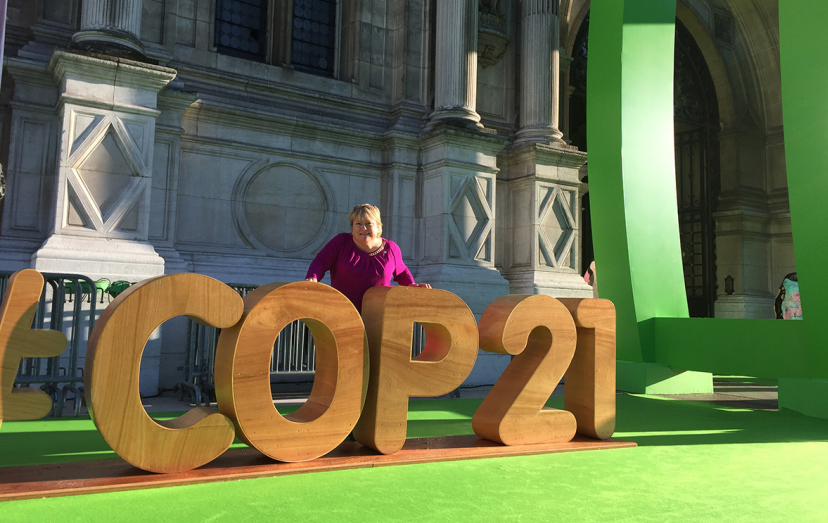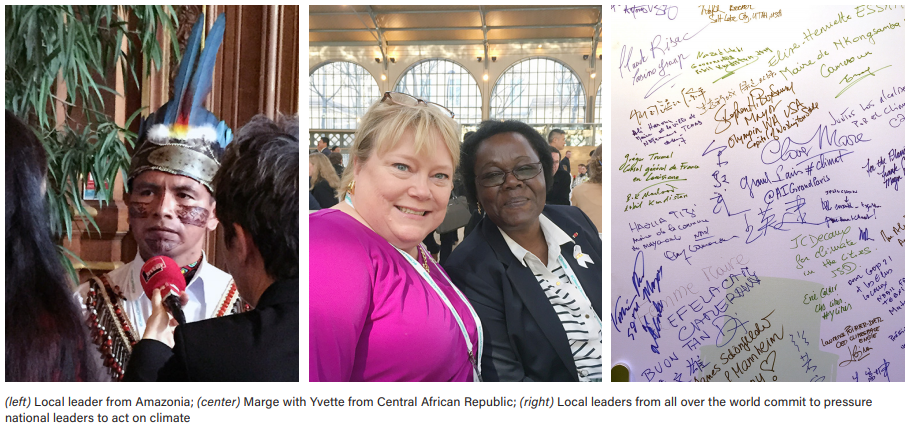
Deep transformation together: inspiration from the Paris Climate Conference
The Renaissance façade of the Hotel de Ville glowed green through the pre-dawn dark. Light trapped by puddles in the street said Emerald City, not Paris. The cobblestones paving the wide, open space in front of this building has gathered the masses since the 13th century. Now, this space held a clean energy forest. A green path led me under twenty-foot flowers with photovoltaic petals, beside trees spinning with tiny wind turbine leaves.
I followed the green carpet under an archway. A spotlight picked out a woman in a Kente cloth headscarf standing between a man in a Louis Vuitton suit and a man from Amazonia with a painted face. Side by side, these mayors wrote on the blank white wall. Together, they declared their commitment to the climate future we share.
On January 20, 2021, the United States recommitted to the Paris Climate Agreement. That was an emotional moment for many of our Slipstream colleagues, including me. One of the great professional privileges of my career was to be in Paris in 2015 as part of the U.S. Green Building Council’s delegation to the COP21. As chair of the board, I participated in two events: the United Nation’s first-ever Buildings Day, and the Cities for Climate event—a gathering that literally glowed green.
Buildings day
Imagine 20 years of climate conferences without a discussion of buildings, which account for 40% of our energy use. The USGBC worked with the World Green Building Council and others to alert COP21 delegates to the massive impact buildings have on climate.
Architecture 2030's Ed Mazria laid down the challenge with his usual blunt style. “By 2060, the world is projected to add new buildings with square meters equivalent to the entire current global building stock. This is the equivalent of adding an entire New York City to the planet every 34 days for the next 40 years.”
Matt Golden of the Investor Confidence Project presented on the financing panel: “Energy efficiency is difficult to package financially; it can’t be measured, only calculated and it’s a decrease rather than an increase” which is not how financial professionals are used to evaluating risk. I read that quote differently now, after two years of working with Slipstream’s finance team. We are helping to change that perception among capital providers, leading them to understand the value delivered by energy efficiency projects.
Cities for climate
I also participated in the Cities for Climate event, hosted by former New York City Mayor Michael Bloomberg and Paris Mayor Anne Hidalgo. The collective will of thousands of municipal leaders representing what Hidalgo called “600 million people ready to act” powered an event that inspired both awe and action.
Michael Bloomberg called on the largest climate change gathering of local leaders “not to make history, but to shape the future,” using their platforms as population centers to pressure national leaders to act on climate. French President Francois Hollande outlined the challenges of environmental justice—that the most vulnerable among us have made the smallest contribution to climate change but suffer the most from climate impacts. “You can’t separate the struggle against climate change from the struggle against poverty.” And I thought of so many of my colleagues back in the office when economist Jeffrey Sachs challenged the mayors to be in “the deep transformation business” acknowledging that no one knows quite how to do this, but that “even more important to the scientists are the engineers for forward-looking and deeply transformative solutions.”

Leaders of Amazonian indigenous communities in Bolivia shared their country’s declaration of rights for Mother Earth. “We must change in our hearts, minds, and heads.” Later they joined other indigenous people from around the world for a floating demonstration down the Seine, reminding the world that indigenous communities often have the most to lose from a warming planet. My notebook is full of quotes from the speakers on the stage, but the people whom I remember most were the mayors I met personally.
I met the mayor of Mariana, Brazil. A month before the COP21, the Mariana dam broke, flooding villages downstream with toxic chemicals, destroying two villages, and killing hundreds. That mayor understood the impact of environmental disasters, and he had come to share his commitment.
At lunch, I sat with Yvette, a mayor from the Central African Republic. Her country ranks dead last on the U.N.’s human development index. 68% of women are married before the age of 18; half the adult population is illiterate. The per capita income there is $750. Her country was torn apart by civil war, struggling with mass displacement, mob violence, and child soldiers. “Why have you come today?” I asked. Yvette told me “I am here for our youth. I am here to remind the world that we exist.” Everyone there knew that they were making a mark on history.

A couple of years later, Doug Ahl gave a presentation to our staff. He said that the time we’re in now reminded him of the beginning of the internet. He talked about machine learning to drive better targeting decisions for programs, and about controls that enabled different technologies to talk to each other for the first time. He reminded us that we’re all in on the beginning of this transformation. That we’re building part of that transformation through our work.
Now, in 2021, the Slipstream team is separated from each other. We sit at our dining room tables—or like me, in our basements. But we’re also standing with those mayors, dressed in their traditional regalia from across the globe. Each of us plays our own small role in shaping our climate’s future. Every loan we process moves an energy project forward. Every lighting installation, every test of new ways technology works together, lives out Jeffrey Sachs’ call for deep transformation. Every visitor to our website who finds a new solution grows the power we have to take on climate change.
Our colleagues are across town and across the country. Yet we at Slipstream are also a part of the collective efforts of millions of people we will never meet. They live in Brazil and in France, in the Central African Republic and deep in the Amazonian rain forest. Together, with our financial, political, technical, and communication solutions, we live out our commitments to our planet and to each other. We are part of the deep transformation that will make history—and that will shape the future.